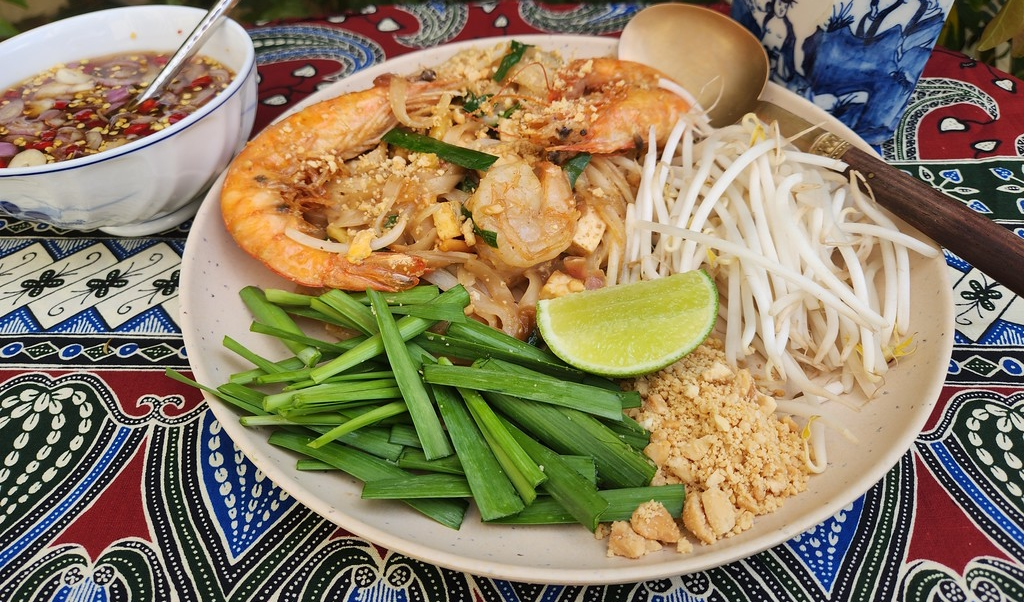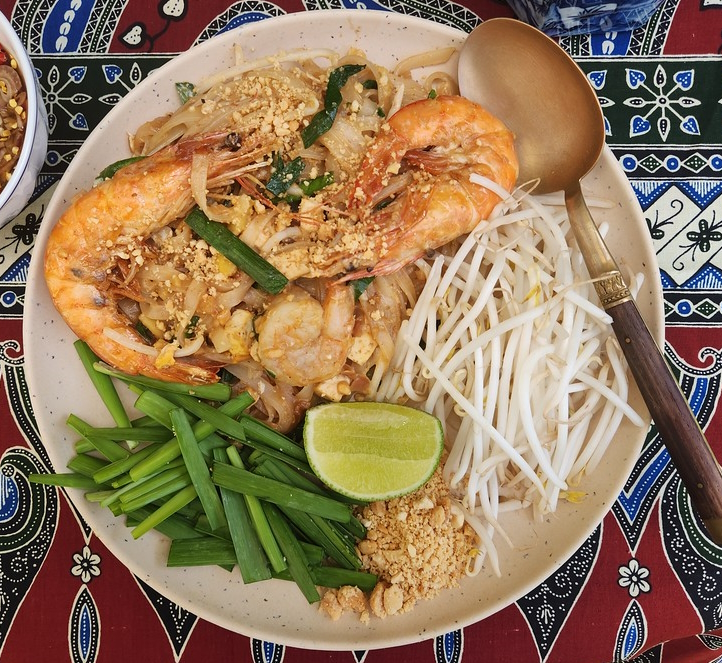Our Recipe for this Month is for Pad Thai, arguably Thailand’s most internationally recognized dish. It's a stir-fried noodle dish that embodies the country’s culinary principles of taste harmony. Sweet, sour, salty, and umami flavors blend with chewy rice noodles, crunchy peanuts, tangy tamarind, and garlic chives to create a melody of flavors.

A couple of weeks ago, I mentioned Pad Thai to my wife and she surprised me when she said that she "loves" Pad Thai. I asked why she never orders it when we go out for Thai food, and she said, "because I haven't had any that tastes anywhere close to the Pad Thai in Thailand". She lived in Thailand for 5 years. I said I didn't try Pad Tai when I briefly visited Thailand, but when I've tried it here, I too was less than impressed. My unfond recollections were soggy noodles, a bland but overly sweet sauce and thoroughly wilted vegetables. This recipe cures that problem.
Contrary to popular belief, Pad Thai is a relatively recent invention. It rose to prominence in the 1930s and 1940s during the regime of Prime Minister Plaek Phibunsongkhram, who sought to modernize and nationalize Thailand (then called Siam). He promoted Pad Thai as a “national dish” in an effort to foster Thai identity, encourage rice noodle consumption (over rice, to support exports), and promote street food as a way to feed a growing urban population during wartime scarcity. While the dish incorporated Chinese-style stir-frying and rice noodles (sen chan), it was adapted with Thai ingredients and flavors, becoming a national culinary treasure.
Pad Thai is a street food staple in Thailand—ubiquitous in night markets and roadside stalls, often customized to each patron's taste. It's not traditionally served in homes or religious ceremonies, but it is street food extraordinaire.
Real Pad Thai uses tamarind paste for its characteristic tang, fish sauce for saltiness, palm sugar for sweetness, and dried shrimp for umami. Like many Southeast Asian dishes, the flavor is delightfully complex. The protein can vary: shrimp is classic, but tofu and chicken are also common.
Thai fermented pickled daikon radish may be hard to find, but 99 Ranch has a version for another country that is excellent. It is one of the ingredients that makes Pad Thai so delicious. You can also find dried shrimp at the same store—it's on the same aisle.
Tamarind comes in a few forms, like a sauce or a block of tamarind. If using the block tamarind, you should use the seedless variety. You must massage the tamarind in warm water to make the sauce. I think we ended up with sauce that was a bit on the thick side, but it was delicious! Palm sugar also comes in a couple of different forms and varies in color from light yellow to dark brown. In Thai it is called Nam Tan Pip, in Indonesia its known as Gula Jawa, and in India it is popularly known as Jaggery. We used Gula Jawa from R99. Light brown sugar is not particularly close in taste, but it does add the required sweetness.
The noodles should be soaked—not boiled—and quickly stir-fried to retain a chewy texture.
Ingredients:
For the Sauce:
- 2 tablespoons tamarind paste
- 2 tablespoons palm sugar
- 2 tablespoons fish sauce
- 2 teaspoons soy sauce
The Noodles and Stir-Fry
- 4 ounces dry flat rice noodles
- 2 tablespoons vegetable oil (divided)
- 2 cloves garlic, minced
- 2 tablespoons of Thai pickled radish chopped small
- 2 tablespoons chopped dried shrimp (optional)
- 8 ounces(170g) shrimp, peeled and de-veined (or chicken/tofu)
- 1 egg
- 1 cup bean sprouts
- 5 stalks garlic chives or green onions, cut into 1" pieces
- 2 tablespoons crushed roasted peanuts
- Lime wedges (for serving)
Preparation:
- Soak the noodles in warm water for 45 minutes.
- Combine tamarind paste, palm sugar, fish sauce, and optional chili flakes in a saucepan over medium-low heat.
- Stir until sugar dissolves and sauce thickens slightly. Set aside.
- Drain the noodles.
- Heat 1 tablespoon of oil in a wok or large non-stick skillet over medium-high heat. Add shrimp (or chicken/tofu) and cook until just done. Remove and set aside.
- Add the remaining 1 tbsp oil. Add minced garlic and dried shrimp. Stir-fry 30 seconds until fragrant but not browned.
- Add the noodles, pickled radish, and sauce.
- Stir-fry on medium-high heat for 1–2 minutes.
- Garnish with crushed peanuts and sprinkle with lime juice.
- Serve with Prik Nam Pla (Thai chili dipping sauce).
Recipe by T. Johnston-O'Neill
Photos by Shari K. Johnston-O'Neill









